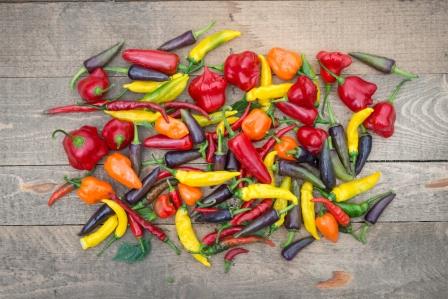Psychic Blog
Hot & Fiery Chillies
3 Nov 2017

In the spirit of Bonfire Night, I thought we would explore hot and fiery chillies. Do you know your Komodo Dragon from your Bird Eye?
There is no doubt that chillies have grown in popularity, sometimes with whole festivals put in place to celebrate everything chilli!
Fact from Fiction
Due to their flavour many people believe that chillies come under the vegetable category, when in fact they are actually fruits. They derive from a flowering plant with seeds inside that produce more chillies.
You might imagine that the heat of the chilli is dependent on size, which it is, but in the case of chillies it is not a bigger is better situation. In fact, the thinner or smaller the chilli the hotter and spicier it will be.
You are probably only familiar with a few chillies – whatever you can get from your local supermarket. But in reality, there are over 500 varieties of chilli and sweet pepper plants in the world.
How Hot Can You Go?
There is actually a scale of measurement for chillies called the Scoville heat units (SHU), essentially it is measuring how much capsaicin is present in the fruit.
What Chilies to Choose
The Komodo Dragon is actually one of the hottest chillies commercially grown in the UK, although it’s got a fruity flavour, you may not get to that as the burn will likely kick in first – it is four hundred times hotter than an average chilli you might cook with – so use at your peril!
You are most likely familiar with red and green chillies, they can be used in all sorts of dishes and offer a medium heat.
Bird Eye chillies might be what you choose if you are cooking a Thai inspired meal, they are very fiery and small in size. Generally, the seeds are discarded not to reduce the heat, but because they can be bitter in taste.
No pantry would be complete without a jar of crushed chilli flakes, fantastic for adding to soup, as well as chilli con carne, anything that requires a hint of warmth. The drying process creates a subtler heat.
Another dried chilli that we are starting to see more of is Ancho, it is often used in Mexican cuisine owing to its smoky flavour. A bit like dried mushrooms they are rehydrated in water before use. Also used in Mexican dishes is chipotle, they are often found canned in adobe sauce and offer a mix of heat and smokiness.
Habanero are often very well known, but they can catch you out – as they range in heat from really mild to off the scale hot!
Scotch Bonnet is famous for being used in Jerk Chicken recipes, it is a super-hot chilli, so follow any recipes carefully!
Health Benefits
The capsaicin in chilli peppers is what gives the plant its health properties. Ranging from detoxing the body by increased sweating, reducing levels of unhealthy cholesterol (LDL), boosting metabolism, minimising hunger and cravings, increasing mucous secretion – thereby helping congestion and sinuses and regulating blood sugar levels to name a few.
Tips
Think about wearing disposable gloves when preparing chillies, but if you don’t, remember not to rub your face or eyes after. Wash your hands thoroughly and if during consumption you find things are too hot – try calming them down with dairy products like yoghurt and milk – then Enjoy!
TweetBrowse Our Blog
Categories
- Blog Home
- Angels
- Astrology
- Book Reviews
- Celebrity
- Crystals
- General
- Love
- Mediumship
- Paranormal
- Readers
- Seasons
- Special-Offer
- Spirituality
- Superstitions
- The Psychic Gift
- Wellbeing